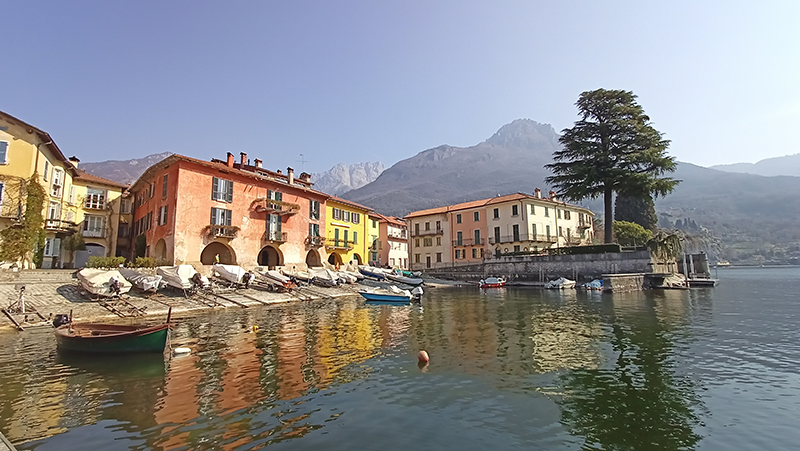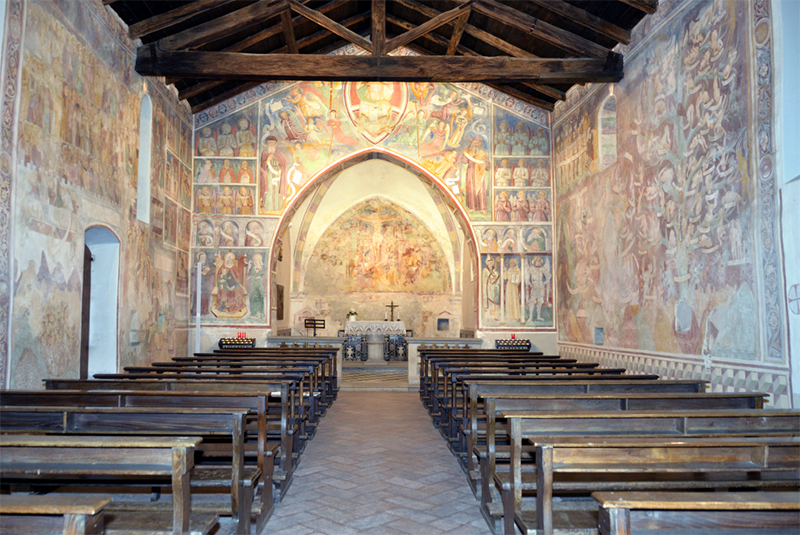Itinerary 1 - The historic village and the Church of S. Giorgio
Our first itinerary in Mandello begins at the pier, in the central Piazza Italia, we are going to visit the historic village of Mandello del Lario and the Church of S. Giorgio.
Reach the arcade in front and walk to the right past the historic Costantin ice-cream shop; after two arcades you soon reach Mandello's most picturesque spot, the old port: an oasis of peace, made up of pastel-colored arches and historic houses decorated with flowering balconies and creepers, all accompanied by the gentle pitching of the boats on the shore. The landscape is postcard-perfect.

Continuing the walk, you arrive at the square Piazza XXV Aprile, where it is nice to discover a children's hopscotch and a chessboard set among the porphyries of the pavement.
Here, on the right, Via Riva d'Adda starts, leading you to a beach.
After the square, we walk down Vicolo all'Asilo and then via Riva Ospizio. Both the small streets that descend to your right lead to cute small beaches.
When you arrive at the former church of San Vittore, the road goes up to the left and becomes Via Monastero. You turn to the first right, via Pra Magno, and pass the Lega Navale and the Mandello del Lario sports club.
When you reach the junction with the provincial road, go up to the right onto salita San Giorgio, an old mule track with stone arches. From here you reach the small Church of San Giorgio, a beautiful example of a Romanesque building dating back to the early Middle Ages, set in a panoramic position with a wonderful view of the lake.
The interior has charming frescoes dating from 1475-1485, which we suggest you visit because they are really unusual and special.
On the triumphal arch is figured Christ surrounded by angels and the prophets Ezekiel and Isaiah. On either side are the nine angelic hosts and six patriarchs. In the lower area on the left, you find St. Brigid, the Virgin and Child, and St. Agatha, while on the right you see St. Blaise, St. Bernardine, and St. Michael the Archangel.
At the bottom of the chancel is a Crucifixion by a local painter.
On the right wall, the most peculiar, Hell is depicted: at the entrance the demon Minos welcomes the damned, in the center is Lucifer surrounded by hosts of vexed souls - as per the rules of Dante's contrapasso; follows then a huge tree whose branches pierce sinners. At the top of the fresco the seven deadly sins are visible.
On the left wall is illustrated the Salvation, from limbo to purgatory to the Resurrection of the dead to Paradise. Next to them is a large number of naked people: these are the redeemed sinners facing in the direction of purgatory and apparently emerging from a crater enveloped in flames.
On the upper right is Our Lady who, surrounded by angels, contemplates the seven works of mercy, namely:
- feed the hungry
- give drink to the thirsty
- clothe the naked
- visit the sick
- lodging the pilgrims
- visit the imprisoned
- bury the dead.
